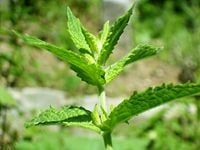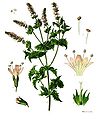Spearmint
- "Spearmint" redirects here.
| Mentha spicata | ||||||||||||||
|---|---|---|---|---|---|---|---|---|---|---|---|---|---|---|
 Foliage
| ||||||||||||||
| Scientific classification | ||||||||||||||
| ||||||||||||||
| Mentha spicata L. |
Mentha spicata (Spear Mint or Spearmint) is a species of mint native to much of Europe and southwest Asia, though its exact natural range is uncertain due to extensive early cultivation. It grows in wet soils.[1][2]
It is a herbaceous rhizomatous perennial plant growing 30–100 cm tall, with variably hairless to hairy stems and foliage, and a wide-spreading fleshy underground rhizome. The leaves are 5–9 cm long and 1.5–3 cm broad, with a serrated margin. Spearmint produces flowers in slender spikes, each flower pink or white, 2.5–3 mm long and broad.[2][3]
Hybrids involving spearmint include Mentha × piperita (Peppermint; hybrid with Mentha aquatica), Mentha × gracilis (Ginger Mint, syn. M. cardiaca; hybrid with Mentha arvensis), and Mentha × villosa (Large Apple Mint, hybrid with Mentha suaveolens).[2]
- Peppermint is an aromatic, usually sterile, natural hybrid plant (Mentha × piperita) that is a cross between watermint (Mentha aquatica) and spearmint (Mentha spicata) and that spreads by rooting.
Overview and description
- mint is the common name for any of the various herbaceous plants comprising the genus Mentha, a taxon of about 25 species of aromatic, almost exclusively perennial plants in the mint family Lamiaceae. They are characterized by wide-spreading, underground rhizomes; erect, square, branched stems; paired, oppositely arranged leaves; and small, tubular flowers arranged in clusters.
- Mentha (mint) is a genus of about 25 species (and many hundreds of varieties) (Davidson 1999). Species within Mentha have a subcosmopolitan distribution across Europe, Africa, Asia (Brickell and Zuk 1997), Australia, and North America. Several mint hybrids commonly occur.
- True mints are aromatic, almost exclusively perennial, rarely annual, herbs. They have wide-spreading underground rhizomes and erect, branched stems. The leaves are arranged in opposite pairs, from simple oblong to lanceolate, often downy, and with a serrated margin. Leaf colors range from dark green and gray-green to purple, blue and sometimes pale yellow (Brickell and Zuk 1997). The flowers are produced in clusters ('verticils') on an erect, terminal spike or in separate wholes, and are white to purple. The flowers have a corolla with two lips with four subequal lobes, the upper lobe usually the largest. The fruit is a small dry capsule containing one to four seeds. All Mentha species are characterized by an essential oil (volatile oil) in resinous dots in the foliage.
A major component of the oil is R-Carvone; pure R-Carvone is sufficient to produce a smell which people identify as a spearmint smell.[4]
The name 'spear' mint derives from the pointed leaf tips.[5]
Cultivation and uses
Spearmint is grown for its aromatic and carminative oil, referred to as oil of spearmint. It grows well in nearly all temperate climates. Gardeners often grow it in pots or planters due to its invasive spreading roots. The plant prefers partial shade, but can flourish in full sun to mostly shade. Spearmint is best suited to loamy soils with plenty of organic material. Spearmint leaves can be used whole, chopped, dried and ground, frozen, preserved in salt, sugar, sugar syrup, alcohol, oil, or dried. The leaves lose their aromatic appeal after the plant flowers. Dry it by cutting just before, or right (at peak) as the flowers open, about 1/2 to 3/4ths the way down the sock (leaving smaller shoots room to grow). There is some dispute as to what drying method works best; some prefer different materials (such as plastic or cloth) and different lighting conditions (such as darkness or sunlight).
The cultivar Mentha spicata 'Nana', the Nana mint of Morocco, possesses a clear, pungent, but mild aroma and is an essential ingredient of Touareg Tea.
Spearmint is an ingredient in several mixed drinks, such as the mojito and mint julep. It is used as a flavoring for toothpaste and confectionery, and is sometimes added to shampoos and soaps. In herbalism, spearmint is steeped as tea for the treatment of stomach ache.
Recent research has shown that spearmint tea may be used as a treatment for mild hirsutism in women. Its anti-androgenic properties reduce the level of free testosterone in the blood, while leaving total testosterone and DHEA unaffected.[6]
ReferencesISBN links support NWE through referral fees
- ↑ Euro+Med Plantbase Project: Mentha spicata
- ↑ 2.0 2.1 2.2 Blamey, M. & Grey-Wilson, C. (1989). Flora of Britain and Northern Europe. ISBN 0-340-40170-2
- ↑ Huxley, A., ed. (1992). New RHS Dictionary of Gardening. Macmillan ISBN 0-333-47494-5.
- ↑ TJ Leitereg, DG Guadagni, J Harris, TR Mon, ... (1971). Chemical and sensory data supporting the difference between the odors of the enantiomeric carvones. Journal of Agricultural and Food Chemistry 19 (4): 785.
- ↑ Turner, W. (1568). Herbal. Cited in the Oxford English Dictionary.
- ↑ http://news.bbc.co.uk/2/hi/health/6376599.stm Tea 'controls female facial hair growth'
- Hanrahan, C., and R. J. Frey. 2005. Spearmint. In J. L. Longe, The Gale Encyclopedia of Alternative Medicine. Farmington Hills, MI: Thomson/Gale. ISBN 0787693960.
Gallery
| Herbs and spices | |
|---|---|
| Herbs | Angelica • Basil • Basil, holy • Basil, Thai • Bay leaf • Boldo • Borage • Cannabis • Chervil • Chives • Coriander leaf (cilantro) • Curry leaf • Dill • Epazote • Eryngium foetidum (long coriander) • Hoja santa • Houttuynia cordata (giấp cá) • Hyssop • Lavender • Lemon balm • Lemon grass • Lemon verbena • Limnophila aromatica (rice paddy herb) • Lovage • Marjoram • Mint • Mitsuba • Oregano • Parsley • Perilla (shiso) • Rosemary • Rue • Sage • Savory • Sorrel • Stevia • Tarragon • Thyme • Vietnamese coriander (rau răm) • Woodruff |
| Spices | African pepper • Ajwain (bishop's weed) • Aleppo pepper • Allspice • Amchur (mango powder) • Anise • Aromatic ginger • Asafoetida • Camphor • Caraway • Cardamom • Cardamom, black • Cassia • Cayenne pepper • Celery seed • Chili • Cinnamon • Clove • Coriander seed • Cubeb • Cumin • Cumin, black • Dill seed • Fennel • Fenugreek • Fingerroot (krachai) • Galangal, greater • Galangal, lesser • Garlic • Ginger • Grains of Paradise • Horseradish • Juniper berry • Liquorice • Mace • Mahlab • Malabathrum (tejpat) • Mustard, black • Mustard, brown • Mustard, white • Nasturtium • Nigella (kalonji) • Nutmeg • Paprika • Pepper, black • Pepper, green • Pepper, long • Pepper, pink, Brazilian • Pepper, pink, Peruvian • Pepper, white • Pomegranate seed (anardana) • Poppy seed • Saffron • Sarsaparilla • Sassafras • Sesame • Sichuan pepper (huājiāo, sansho) • Star anise • Sumac • Tasmanian pepper • Tamarind • Turmeric • Wasabi • Zedoary |
Credits
New World Encyclopedia writers and editors rewrote and completed the Wikipedia article in accordance with New World Encyclopedia standards. This article abides by terms of the Creative Commons CC-by-sa 3.0 License (CC-by-sa), which may be used and disseminated with proper attribution. Credit is due under the terms of this license that can reference both the New World Encyclopedia contributors and the selfless volunteer contributors of the Wikimedia Foundation. To cite this article click here for a list of acceptable citing formats.The history of earlier contributions by wikipedians is accessible to researchers here:
The history of this article since it was imported to New World Encyclopedia:
Note: Some restrictions may apply to use of individual images which are separately licensed.


